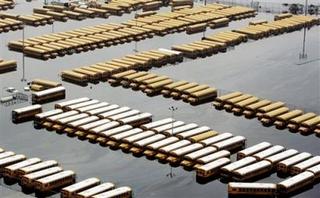President Bush has been identified as public enemy number one for a)"divert[ing] funds from the rebuilding of the New Orleans levees to Iraq" ; b)not sending the National Guard in fast enough; c)continuing his vacation while New Orleans was drowning; and a host of other crimes.
What's the point of these recriminations? There is none. After the city has been evacuated and rebuilding begins, there will be time to assess the evacuation. This should be done in order to learn from our mistakes in the event of another disaster, not so we can identify the Great Satan behind the catastrophe.
In the meantime, let's look at some of the facts.
In truth, we've known for years that New Orleans was a disaster waiting to happen. The Army Corps of engineers has been working on protecting New Orleans from flooding for 40 years and had managed to construct a system that experts felt would protect the city from a Category 3 storm. But as storm prediction became more sophisticated, the Corps came to the realization that the levees it constructed might not be high enough to counter "the big one." Funding for such a project had not yet been approved in 2003. But even if it had, it would have taken another 30 years for the project to be completed.
Here's something else we knew, which I blogged about earlier but deserves to be repeated:
For the most part, New Orleans does not have places for people to go. The American Red Cross no longer provides emergency shelters in the city because its officials cannot guarantee the structural integrity of the locations. There simply are not enough buildings in the area that could withstand the forces of a category 4 or 5 storm.
During the past 10 years Marc Levitan, a wind and structural engineer and the director of LSU’s Hurricane Center, has been involved in hundreds of building investigations throughout New Orleans to determine if certain structures could be used as so-called refuges of last resort. “With the vast majority of them, if you really do an analysis, you really wouldn’t want to use them,” he says. “They all have some sort of deficiency.”
Most people would not wish to remain in the city if a category 4 or 5 storm were in prospect, but evacuating could be difficult. Experts say close to 400,000 people could be stranded in the city. There are an estimated 100,000 people without easy access to automobiles, and those who can drive may not be able to do so. During Hurricane Andrew, interstates throughout the South were brought to a standstill because simultaneous evacuations were taking place in several states. The only major planning improvement since then has been the decision to keep traffic away from the coast on both sides of evacuation routes.

Flooded school buses in New Orleans.(AP) Hat tip: Gateway Pundit.
Given this knowledge, one might well ask why New Orleans officials decided to send people without transportation to the Superdome instead of comandeering those school buses to get those people out of town? Remember, they knew that yp to 20 percent of the city's population did not have the wherewithal to leave town on their own steam.
Instead, the only person who thought of putting an abandoned bus to work, Jabbor Gibson, may be prosecuted for taking the initiative. Also, remember that the evacuation was "unprecedented" and only came about because President Bush called local officials and asked them to evacuate the city. Further, on Monday, common wisdom had it that New Orleans was spared Katrina's wrath. I remember listening to NPR that morning and they were interviewing people in the French Quarter who had returned to New Orleans to check up on their property.
And then there's New Orleans' dirty little open secret.
Katrina didn’t turn innocent citizens into desperate criminals. This week’s looters (not those who took small supplies of food and water for sustenance, but those who have trashed, burned, and shot their way through the city since Monday) are the same depraved individuals who have pushed New Orleans’ murder rate to several multiples above the national average in normal times. (New Orleans, without Katrina, would have likely ended 2005 with 330 or so murders—compared to about 65 in Boston, a city roughly the same in size.) Today may not be the best day to get into New Orleans’ intractable crime problem, but it’s necessary, since it explains how this week’s communications and policing vacuum so quickly created a perfect storm for the vicious lawlessness that has broken out.
New Orleans is really two cities: The "European-like" tourist destination--birthplace of jazz--with its world-class restaurants, wrought-iron balconies and decorative vegetation; and a third world nation of desperate poverty, its citizens living on public assistance and serving as prey for a criminal class that city, state and federal officials have made only half-hearted attempts to address. The middle class moved out long ago.
Think of it as Cuba, current vacation destination of our neighbors to the north and various Eurotrash, in the middle of the United States. On the one hand, people are living the good life, soaking up the sun, sounds and tastes of the city; while only blocks away people are living in substandard housing and being tormented by vicious gangs.
So when rescuers began their work they became targets of this criminal class. In effect, the National Guard had to fight a war while trying to rescue people from a 180-square-mile soup bowl full of water and toxic waste.
When the evacuation is complete and cooler heads prevail, we will likely find that many mistakes had been made. But now is not the time to point fingers. Now is the time to support the relief effort.
Technorati Tags: flood aid, Hurricane Katrina
No comments:
Post a Comment